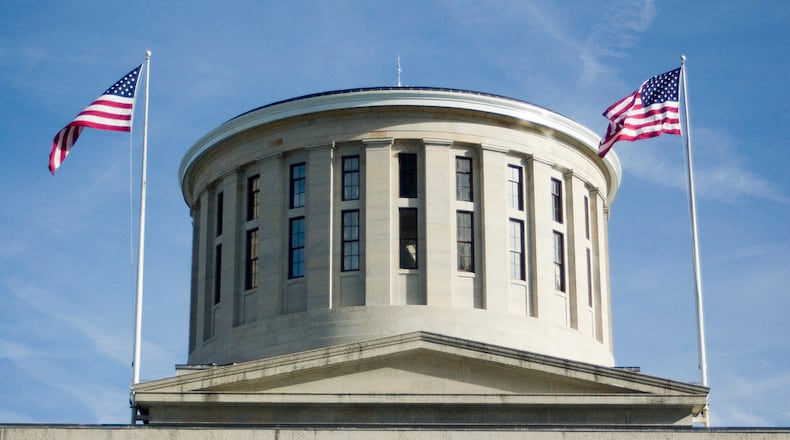“I’ve had some changes in my district. I’m really not sure what they are yet, totally,” he said. “Nothing Earth-shattering.”
Statewide, though, there are “a lot of changes,” which he believes make for greater fairness.
“The process was a good process,” Plummer said.
It’s to be expected that some people are happy with the results and some others aren’t, he said.
Fair Districts Ohio, an advocacy group backed primarily by the League of Women Voters and Common Cause, dissected the Republican proposal Friday in an online press conference, while announcing the winners of its own public map-drawing contest.
David Niven, associate professor of political science at the University of Cincinnati, said the Fair Districts Ohio contest results show it’s not really hard to draw maps that meet all legal requirements.
“The Ohio constitution very clearly says that a map can’t be drawn to favor or disfavor a party,” he said. “This map fails disastrously in every way you could possibly measure it. This map is almost the definition of gerrymandering.”
The Republican proposals could give them 60% of legislative seats even if Republicans didn’t get a majority of votes statewide, said Niven, a member of the advisory board that chose the Fair Districts Ohio contest winners.
Republican state lawmakers unveiled their proposal Thursday, and the Republican-dominated redistricting commission gave it tentative approval on a 5-2, party-line vote. Senate Democrats submitted map proposals last week but the commission rejected them, again on a party-line vote.
Commissioners are expected to consider amendments to the Republican proposal and vote on a final map Sept. 15, the legal deadline.
Ohio voters approved constitutional amendments in 2015 and 2018 that created a new process for drawing both state legislative and congressional district maps and set up the redistricting commission. This is the first time the new process has been used, based on 2020 census data.
If the commission approves a map for Ohio General Assembly seats without support from the panel’s two Democrats, it will have to be redrawn in four years. If a map gains bipartisan approval it would be in force for a decade.
State Sen. Bob Hackett, R-London, said the proposed map for his 10th District didn’t change, covering Madison, Clark and Greene counties; but the three House district maps for the same area changed slightly.
State Rep. Willis Blackshear Jr., the only Democrat representing the Dayton area, did not return calls seeking comment.
The Republican-proposed House and Senate maps fail to meet standards for proportionality and competitiveness, said Chris Cusack, professor emeritus of geography at Keene State College in New Hampshire. Proportionality means drawing districts that would likely produce election results matching voters’ known political preferences. Competitiveness means districts that give each major party a chance of winning.
The Republican Ohio Senate proposal would likely produce a chamber with 70% Republican seats and only two competitive races, said Cusack, who serves as redistricting technical manager for Fair Districts Ohio. Republicans currently hold 76% of Senate seats.
Their Ohio House proposal would probably result in 67% Republican seats, with only one competitive district, he said. Currently Republicans hold 65% of the House.
State Sen. Niraj Antani, R-Miamisburg, had a different take.
“The map released by the Ohio Redistricting Commission is one that will serve Ohioans well,” he said. “It is constitutional, meeting the requirements laid out, as well as keeping communities as compact and intact as possible. It certainly appropriately reflects population changes, and I think it will be a great map for the Miami Valley.”
Republican mapmakers sought to “crack and pack” minority communities, cutting representation for people of color, said Rev. Brandi Slaughter, executive director of the Ohio Council of Churches. The proposal is worse than the current legislative map, and doesn’t meet 14th Amendment or Voting Right Act standards, she said.
The public now has access to software mapping tools that official mappers have used for years, and those tools are much better than they were a decade ago, said Catherine Turcer, Common Cause Ohio executive director.
A committee chose three winners of the Fair Districts Ohio contest from 30 submissions: Geoff Wise of Cincinnati and Pranav Padmanabhan of Columbus shared first place, and Paul Nieves of Yonkers, New York, was named third-place winner.
To be considered, all maps had to meet all legal requirements, and three of the 99 state House seats had to be “nested” within each of the 33 state Senate districts, Cusack said.
The Ohio Redistricting Commission will hold three public hearings on the Republican map proposal before its expected final vote on Sept. 15:
• 4 p.m. Sunday, Sept. 12, at Washington Twp. Recreation Center, 895 Miamisburg Centerville Road in Dayton;
• 4 p.m. Monday, Sept. 13, at Corporate College East in Warrensville Heights; and
• 10 a.m. Tuesday, Sept. 14, at the Ohio Statehouse in Columbus, with remote testimony from Washington State Community College in Marietta.
Fair Districts Ohio will lobby for changes in the proposed maps, but if a gerrymandered final version is approved, the group would consider lawsuits, said Jen Miller, director of the Ohio League of Women Voters.
About the Author

